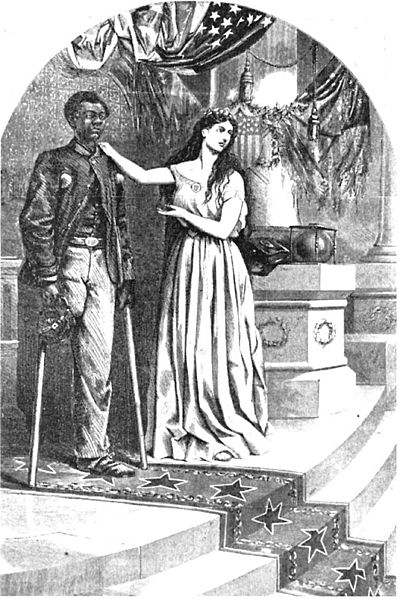Earlier in this roundtable of hate Alex Buchet wrote about racism in European kids comics. Among other things, he pointed out that the skill of the rendering in this case compounded rather than excused the crappiness of the comics. Skill used in pursuit of vice is itself a vice, not a virtue.
I think this also arguably applies to the work of Thomas Nast. In particular, I’m thinking of a couple of Nast’s cartoons which were highlighted in James Loewen’s excellent book Lies My Teacher Told Me. Loewen first points to the illustration below.
The cartoon was titled “And Not This Man?” and was printed in Harper’s Weekly, August 5, 1865. As Loewen says, the cartoon “provides evidence of Nast’s idealism in the early days after the Civil War.” It also shows the strong memory of black’s recent service in the Union army, and links that service directly to their citizenship, their equality, and their suffrage rights.
Here is another Nast cartoon, from nine years later.
This one is titled “Colored Rule in a Reconstructed(?) State.” Again, it was printed in Harper’s Weekly; the date was March 14, 1874. As Loewen says, “Nast’s images of African Americans reflected the increasing racism of the times…. Such idiotic legislators could obviously be discounted as the white North contemplated giving up on black civil rights.”
I think it’s clear enough that the second cartoon is, on its own merits, a vicious and evil racist piece of shit, which uses blackface imagery and racist iconography to (as Loewen says) justify inequality and discrimination. This sort of imagery and language was the basis for 100 years of Jim Crow. Moreover, this vision of Reconstruction still undergirds neo-Confederate sentiment and racism to this day.
But the second cartoon is only more painful when compared to the first. Sometimes cartoonists are excused their use of racist caricature on the grounds that they couldn’t have known better at the time, or that everyone was doing it back then. But, clearly, Nast did know better, and was perfectly capable of drawing black people without using caricature when he felt like it. He became more racist over time, not less. His racism was a function of his era, but it was not a function of simply living in the past. Rather, he was racist specifically because he was capitulating to a society which was becoming more racist — and not only was he capitulating, but he was actively encouraging that transformation. America betrayed its ideals…and Nast betrayed his own right along with those of his country.
And if Nast was culpable in 1874…well, it’s hard to see how Winsor McCay wasn’t culpable in the early 20th century, or how Eisner wasn’t culpable even later. Racial idealism wasn’t foreign to America; artists who were sufficiently intelligent or brave or moral had an iconographic and ideological tradition to draw on if they wanted to present black people as human. Cartoonists who chose not too — like Nast in 1874, or McCay and Eisner later — or Crumb later than that — were making a choice.
Along the same lines, I think these images show that Nast’s formal powers were deliberately and maliciously perverted. He used his considerable skills (evident even in these crappy scans) to make caricature look natural and feasible, to ridicule the weak, and to portray the Reconstruction period as one of chaos and monstrosity. If he were a lesser artist, the drawing would be less effectively racist. But even beyond the utilitarian argument, the second drawing seems more evil because we know, from the first, that Nast is capable of seeing and depicting black people as human. His betrayal is more thorough because there is a talent and a vision there to betray.
These cartoons don’t exactly make me angry the way that the comics I dislike the most make me angry. I was really furious after reading In The Shadow of No Towers, for example — the pompousness, the tediousness, the stupidity, all seemed to be speaking directly to me in a way which I’m afraid I took personally. That second Nast cartoon, though, is so old, and so clearly ideologically repellant that looking at it I don’t feel individually assaulted — just depressed and a little despairing for my country. Still, while it’s not my least favorite, I think that the magnitude and influence of its betrayal puts it in the running for being the worst comic ever.
__________
Click here for the Anniversary Index of Hate.




